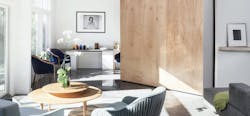The pandemic has shown how quickly we can adjust to work-from-home life. Ivy Ross, head of product design at Google, is among the many trying to stay productive while working remote. She also leads a team that designs future products for the home. So how do we build in the most flexibility into our environments so they accommodate different modes of being?
Related to flexible design: Open offices and open home floor plans have both been the rage for years. But as social distancing has proven paramount, COVID-19 has already challenged the open office, and Ross imagines that the same thing is happening to open homes—though only to an extent.
“I think we’re going to create things like a bookshelf that can be on wheels that can become the room divider,” says Ross. “I don’t think we’re going back to small rooms, but I think we’ll be clever about how objects can serve these purposes when we need it.”
Indeed, one report puts the average cost for a small business to redesign its space at $200 per square foot, meaning retrofitting a single room can cost tens of thousands of dollars. It seems unlikely that in this economy especially, a majority of businesses will be able to readily reconsider their full layout. But individual items could help, especially if they can come into your life without cluttering it up.
